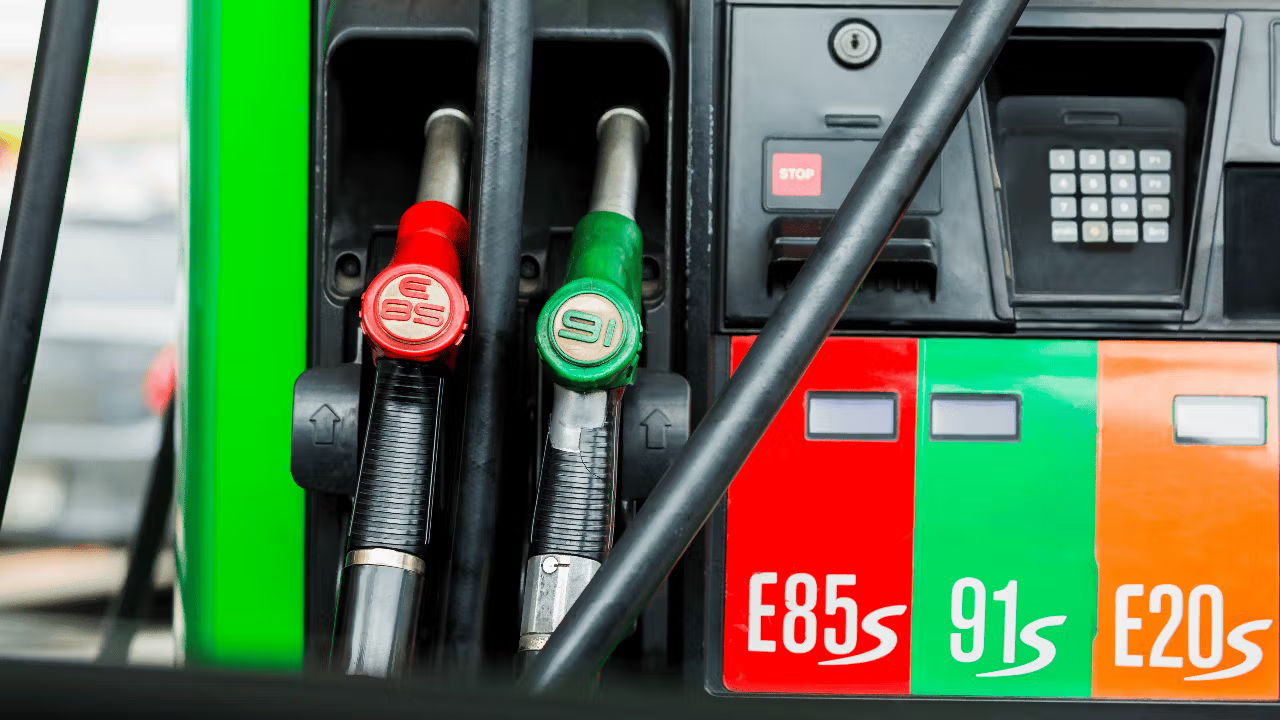
In a world increasingly conscious of environmental sustainability and energy efficiency, the question, "What is E85 gas?" gains significance. E85, a dynamic player in the realm of ethanol gasoline blends, stands at the forefront of alternative fuels. This flex fuel is not just about powering vehicles; it's a narrative of innovation, environment-friendly practices, and a nod to the Renewable Fuels Association's vision. Through this exploration, we're not just demystifying a fuel type; we're unfolding a chapter in the evolving story of automotive fuels. E85 represents a bridge between traditional energy and a renewable future, offering a fascinating glimpse into the potential of ethanol in revolutionizing how we drive. Stay tuned as we dive deep into the world of E85 gas, where every drop tells a story of change and possibility.
Join our newsletter
Stay on top of the latest in landscaping and lawn care with one valuable tip right in your inbox every Saturday morning.
What is E85 Gas?
The Basics of E85 Gasoline
E85 gas, a term that resonates with innovation in fuel technology, stands for an ethanol gasoline blend predominantly used in flex fuel vehicles. Its composition is unique, consisting of about 85% ethanol and 15% gasoline, a stark contrast to regular gasoline. The high ethanol content in E85 offers distinct advantages and characteristics. Ethanol, typically derived from corn and other plant materials, is a renewable resource, making E85 a more sustainable choice.
E85 vs Regular Gasoline: Understanding the Difference
Comparing E85 gas to regular gasoline reveals significant differences, primarily in composition and environmental impact. Regular gasoline predominantly consists of refined crude oil with varying octane levels. In contrast, E85's high ethanol content significantly reduces the volume of fossil fuels per gallon, making it a greener alternative. This difference not only affects the environment but also the way vehicles operate. E85 is specifically designed for flex fuel vehicles that can adapt to its higher ethanol levels, offering an eco-friendlier and often more cost-effective fuel option. Through this lens, E85 gas emerges not just as a fuel, but as a key player in the push towards sustainable and renewable energy sources.

How Ethanol-Based Fuel Works
The Science Behind Ethanol and Gasoline Mixtures
The ingenuity of ethanol-based fuel lies in its blending of ethanol with gasoline, creating a synergy that benefits both vehicles and the environment. Ethanol, a biofuel derived from renewable resources like corn and sugar cane, offers a high octane rating. This property makes it an excellent additive to gasoline, enhancing the fuel's ability to resist engine knocking and improving overall performance.
The blend, such as in E85 fuel, capitalizes on these properties. In ethanol engine design, engineers tailor engines to exploit ethanol's higher octane rating. This design adjustment allows for a more efficient fuel burn and a reduction in harmful emissions. The base ethanol engine design often involves modifications to fuel injection systems and engine calibrations to accommodate the different chemical properties and energy content of ethanol compared to traditional gasoline.
Through this meticulous blending and design process, ethanol-based fuels like E85 emerge as not just an alternative but a sophisticated, environmentally-conscious choice. They embody a shift towards leveraging renewable resources in powering our vehicles, aligning with broader goals of sustainability and reduced environmental impact.
Why E85 Might Be Better for Consumers, Cars, and the Environment
Environmental Benefits of Using E85
The adoption of E85 flex fuel is a stride towards environmental stewardship. Ethanol, being a renewable resource, significantly reduces greenhouse gas emissions when burned compared to traditional gasoline. This shift to E85 means less reliance on fossil fuels, thus contributing to a decrease in overall carbon footprint. Moreover, the production of ethanol supports sustainable agricultural practices, which further bolsters its environmental credentials. Vehicles running on E85 emit fewer pollutants, making them friendlier to the air we breathe.
E85 and Vehicle Performance: Pros and Cons
Switching to E85 flex fuel offers a mixed bag in terms of vehicle performance. On the positive side, the higher octane rating in E85 can lead to increased horsepower and torque, providing a more responsive driving experience. It can also contribute to a better fuel economy in some engine designs. However, E85 has a lower energy content per gallon compared to regular gasoline, which can result in less energy efficiency and reduced miles per gallon. Vehicle owners need to weigh these factors based on their driving habits and vehicle specifications. Additionally, the engine and other components of flex fuel vehicles are specifically designed to accommodate E85's unique properties, ensuring compatibility and maintaining the longevity of the vehicle. This adaptability underlines the potential of E85 as a viable fuel alternative, balancing performance with ecological benefits.

The Practicalities of E85 (Flex Fuel)
Use in Flexible-Fuel Vehicles
Flex fuel vehicles (FFVs) are engineered to utilize E85, a versatile ethanol blend. These vehicles are designed with a multi-fuel capability, allowing them to run on E85, regular gasoline, or any mixture of the two. The key to their adaptability lies in their advanced engine management systems and fuel sensors, which automatically adjust the fuel injection and ignition timing based on the ethanol content. This flexibility is a boon for consumers, offering a choice between fuels based on cost, availability, and environmental concerns. The use of E85 in flex fuel vehicles represents a significant step towards reducing dependence on pure fossil fuels, showcasing a practical approach to incorporating renewable energy sources in everyday life.
Finding and Using E85 Gas Stations
While E85 is gaining popularity, locating E85 gas stations can be a challenge in some areas. However, the network is expanding, making E85 more accessible to a broader user base. Drivers can find these stations using specialized apps or online directories dedicated to flex fuel options. At the pump, E85 is clearly labeled to distinguish it from regular gasoline, ensuring that users can easily identify the correct fuel for their FFVs. The process of refueling is similar to traditional fuels, making the transition to E85 seamless for consumers. This growing availability not only supports the use of flex fuel vehicles but also encourages a shift towards more sustainable fuel choices.
Should You Use E85 Fuel In Your Vehicle?
Determining whether to use E85 flex fuel begins with assessing your vehicle's compatibility. Not all vehicles can handle the high ethanol content of E85, and using it in a non-compatible vehicle can lead to operational issues. Automotive manufacturers typically specify if a vehicle is E85 compatible in the owner's manual or with a badge on the fuel door. Flex-fuel vehicles are equipped with special components like ethanol sensors and modified fuel tanks that can withstand the corrosive nature of ethanol. It's essential for vehicle owners to check these specifications before considering a switch to E85.
Long-Term Effects on Engine Health
Using E85 in compatible vehicles generally does not adversely affect the engine's health. In fact, the higher octane rating can even enhance performance. However, it's crucial to monitor any changes in engine performance or fuel efficiency over time. Some studies suggest that long-term use of E85 might cause more rapid wear in some engine parts due to its corrosive nature, though modern FFVs are designed to mitigate these effects. Regular maintenance and check-ups are advisable to ensure the vehicle continues to operate efficiently and effectively with E85 fuel.
Join our newsletter
Stay ahead of the curve in all things outdoor.
Get the inside scoop on the latest landscaping, lawn care, and fencing trends with 1 actionable tip every Saturday morning.
E85 vs Gas Performance
When comparing E85 gas to regular gas, a notable difference emerges in terms of power output. E85, with its higher ethanol content, typically offers a higher octane rating than regular gasoline. This higher rating can lead to increased power and torque in engines designed to take advantage of it. As a result, vehicles running on E85 might experience a more responsive and robust performance, particularly under high-load conditions. However, this benefit is most pronounced in engines specifically tuned for high ethanol content fuels.
Efficiency and Mileage Comparison
The efficiency story between E85 gas and regular gas is complex. While E85's high octane rating can improve combustion efficiency, its lower energy content per gallon means that vehicles tend to consume more fuel. Consequently, miles per gallon (MPG) ratings are generally lower for E85 than for regular gasoline. This decreased fuel efficiency can be a significant consideration for drivers, especially in areas where E85 is comparably priced to regular gasoline. Ultimately, the choice between E85 and regular gas hinges on balancing the desire for increased engine performance with the potential trade-offs in fuel efficiency and operational costs.

Economic and Ethical Considerations
Do You Want To Save Money On Fuel?
The economic aspect of using E85 revolves around fuel costs. Often, E85 is priced lower than regular gasoline, making it an attractive option for cost-conscious consumers. However, it's important to consider the fuel efficiency aspect. Due to its lower energy content, vehicles running on E85 may require more frequent refueling, potentially offsetting the cost benefits. Consumers should evaluate the price per mile rather than the price per gallon to make a comprehensive cost assessment.
Food vs. Fuel: The Ethical Debate
E85, primarily produced from crops like corn and sugar cane, brings forward the 'food vs. fuel' ethical debate. Critics argue that diverting these crops for ethanol production could impact food supplies and prices, particularly in regions where these crops are staple foods. However, ethanol producers and American farmers advocate the use of surplus and non-edible parts of crops for ethanol, aiming to balance both food and fuel needs. This debate highlights the complexity of integrating biofuels into our energy mix, necessitating a careful consideration of both economic and ethical dimensions.
Advanced Topics in E85 Usage
E85 Fuel System Upgrades for Classic EFI
Adapting older vehicles, particularly those with Classic Electronic Fuel Injection (EFI) systems, for E85 use involves several technical considerations. Automotive engineers recommend upgrades to the fuel system to handle the ethanol gasoline blend effectively. This includes installing ethanol-compatible fuel lines, pumps, and injectors, as pure ethanol can be more corrosive than traditional gasoline. Additionally, adjusting engine settings to accommodate the different stoichiometric fuel ratio of E85 is crucial for optimal performance. These modifications not only enable older vehicles to run efficiently on E85 but also often result in enhanced engine performance due to the high octane rating of the fuel.
Advantages and Disadvantages of Ethanol-Based Fuel
Ethanol-based fuels like E85 come with their set of advantages and disadvantages. On the plus side, they offer a renewable, more environmentally friendly alternative to pure gasoline, potentially reducing emissions and dependence on fossil fuels. The high octane rating of ethanol can also lead to improved engine performance and efficiency. However, the downsides include lower energy content, leading to reduced fuel economy, and potential compatibility issues with older vehicles not designed for high ethanol content. These factors must be weighed by consumers and policy makers when considering the broader adoption of ethanol-based fuels in the automotive sector.

Conclusion: The Future of E85 and Flex Fuel
As we conclude our exploration of E85 gas, it's clear that this flex fuel embodies the dynamic intersection of innovation, sustainability, and practicality. Championed by entities like the Renewable Fuels Association, E85's high ethanol content not only serves to reduce environmental impact but also paves the way for more efficient and cleaner vehicle technologies. The future prospects of E85 seem bright, particularly as automotive manufacturers continue to develop vehicles optimized for this fuel. The journey of E85 is far from static; it's an evolving narrative that reflects our growing understanding of renewable energy sources and their potential role in reducing our carbon footprint. As we look forward, E85 stands as a beacon of progress, symbolizing a collective effort towards a more sustainable and energy-efficient world.
Join our newsletter
Stay ahead of the curve in all things outdoor.
Get the inside scoop on the latest landscaping, lawn care, and fencing trends with 1 actionable tip every Saturday morning.